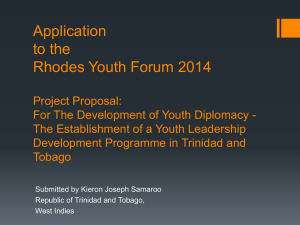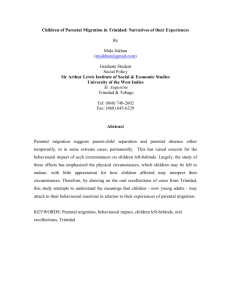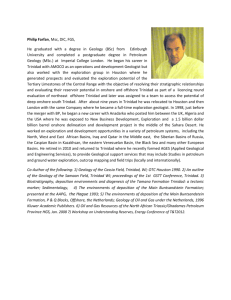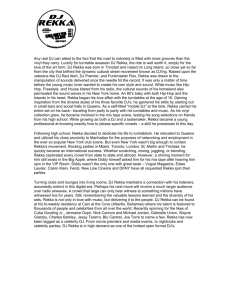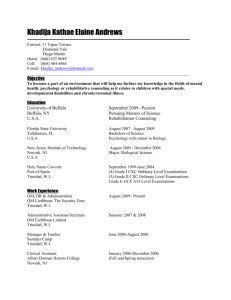Click here to read Trini Paean
advertisement
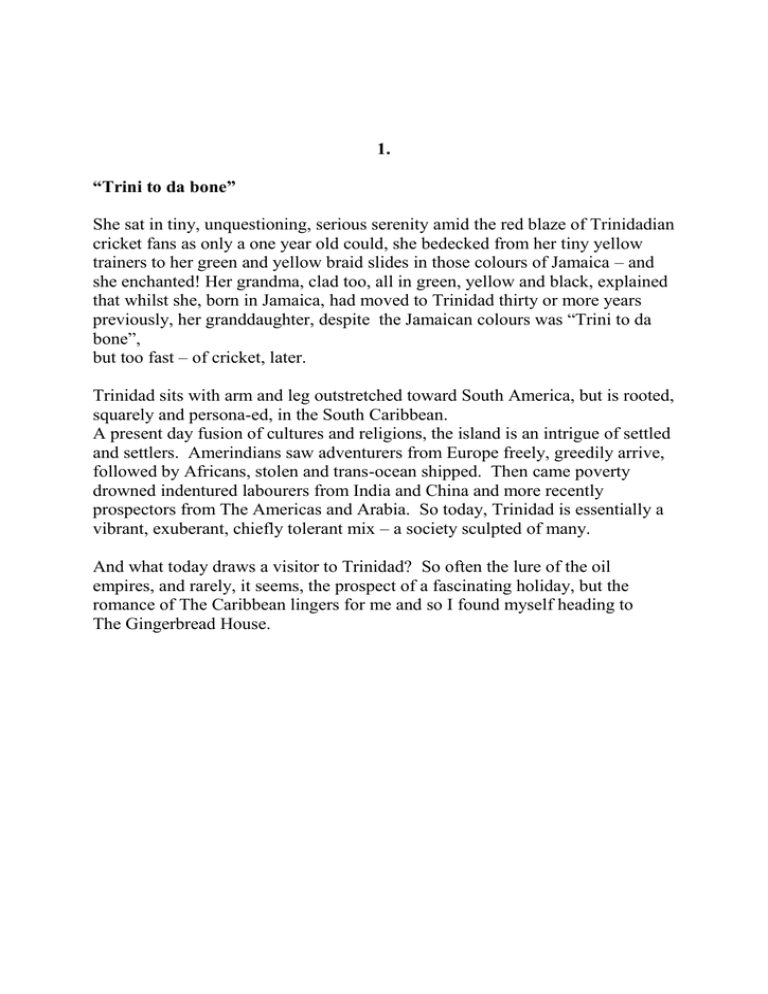
1. “Trini to da bone” She sat in tiny, unquestioning, serious serenity amid the red blaze of Trinidadian cricket fans as only a one year old could, she bedecked from her tiny yellow trainers to her green and yellow braid slides in those colours of Jamaica – and she enchanted! Her grandma, clad too, all in green, yellow and black, explained that whilst she, born in Jamaica, had moved to Trinidad thirty or more years previously, her granddaughter, despite the Jamaican colours was “Trini to da bone”, but too fast – of cricket, later. Trinidad sits with arm and leg outstretched toward South America, but is rooted, squarely and persona-ed, in the South Caribbean. A present day fusion of cultures and religions, the island is an intrigue of settled and settlers. Amerindians saw adventurers from Europe freely, greedily arrive, followed by Africans, stolen and trans-ocean shipped. Then came poverty drowned indentured labourers from India and China and more recently prospectors from The Americas and Arabia. So today, Trinidad is essentially a vibrant, exuberant, chiefly tolerant mix – a society sculpted of many. And what today draws a visitor to Trinidad? So often the lure of the oil empires, and rarely, it seems, the prospect of a fascinating holiday, but the romance of The Caribbean lingers for me and so I found myself heading to The Gingerbread House. 2. Run, run as fast as you can – to The Gingerbread House. To any Trinidadian a gingerbread house means less iced biscuit treat, more a feast of wood latticework decorated house built whilst Queen Victoria still ruled the waves – and the island. The MacKay’s gingerbread house though, is like so much Trinidadian, a fusion of styles – a wonderful white wooden house, plant and art filled veranda hugged, with modern touches of Mackintosh and Art and Craft, home to a fusion family, urbane Bernard, Trinidadian architect, Rosemary, intuitive English lady and daughter Nat, like the young cricket fan, “Trini to da bone”. Add Panther, the driver, conversationalist on topics wide from Carnival to cooking kalalloo, Mr. James, wise and cricket savvy, beautiful Sparkle, elegant Sandra and bubbly Gillian – and the mix is mixed. The rooms, airy and cool, don’t demur from surprise. Original white wood shuttered doors hide truly 21st century stone, glass and stainless steel bathrooms with art deco-ed windows. And outside the garden dashes quirk. Takemitsu intervalled windchimes, “croc” guarded splash pool, pond, pomegranates and palms, all overflown by corbeaux and frigate birds, chatbustled by bananaquits, secreted by alert lizards, and by night, filled, oh so filled, with the whistle of translucent frogs, and all shadow-guarded by a crescent moon, indolent on its back. This is the wonderful Gingerbread House experience - but to move on. 3. Taxi tales. “Driver, you think they gonna secure that port? Driver, you think they can? Nooo way, driver!” The speaker, wiry, joyfully dressed with beanie hat topping, sits to my left in the route taxi. To my right, a rotund, be-suited, perspiring young man, hugging a new briefcase, sits, silent. And I, betwixt, learn. I learn the opinion of my hatted neighbour, prompted by local news on taxi’s radio, of the proposal by the Port of Spain port authority to cut smuggling; I learn that the first day of the month, bringing yet another youth murder, is of no surprise to my fellow; I learn too that the driver, whilst taciturn, is listening, considering. And I begin the learning that route taxis are a phenomenon! Route taxi drivers provide a staple, affordable, fixed price part of Trinidad’s public transport system, taxis running a set route, leaving the city centre when full and picking up fares as spaces appear. However, to think of route taxis as mere transport is to underrate, nay, insult their role. These are not just the purveyors of the travelling public – they are the purveyors, too, of opinion and debate, purveyors of Caribbean music of every bubbling genre and transient purveyors, ebullient with Trini lives. The taxi turns into a traffic swallowed suburban street, so slows and stops. Outside on the hot, midday pavement, a toddler is defying his harassed mum. My behatted fellow , leans out of the taxi window, and tapping the surprised youngster on the top of his head, says, “You do what your momma does say…………….” and as the traffic untwines, and we pull away, shouts, not at all unkindly, “………….. or I gonna get ya!” and guffaws. And later, as I left the taxi, necessitating his getting out of the car too, he holds my arm, calls me “Madam”, hands me courteously over some litter, onto the pavement – and is gone, together with the driver, the nervous young man – and his own opined opinions. 4. “Beyond the Boundary” – a borrowed naming. I was under the weather, moping around The Gingerbread House, when Rosemary, graduate in English literature from the University of the West Indies, handed me an elderly book. “I know you like cricket…” she said, “… you might fancy this.”, and so it was that I entered the fascinating world of the 20th century cricket enthusiast and global thinker, Trinidadian, C.L.R. James. The book, “Beyond the Boundary”, spins an intriguing plaited thread, lacing cricket to life, life to cricket, and borrowing and adapting in explanation a Kipling quote , “What do they know of cricket who only cricket know?”. Little did I realise, as I waited to buy my ticket for Queen’s Park Oval, snuffling and sneezing, inhaled by a chipping cacophony of scarlet noise, laden cool boxes and good humoured, high decibel banter, that whilst I expected cricket, Trinidadian life, beyond the boundary, was what I would actually experience at the top of those concrete steps! West Indies cricket is always a pleasant, noisy alternative to the panama-hatted gentility of Lords, but stepping out into the stand at a Sunday Queen’s Park Oval, when Trinidad are playing Jamaica, is to be swept away on a magic carpet, shimmering, woven of sound, colour, excitement, expectation, talk and opinion – Trinidad! To be candid, I, like Mr. James, though willing a home victory, was dubious. Mr. James, by now my cricket fellow, had admitted, “Those Jamaica boys, they can bat all the way – can hit big.”. I rather agreed. So as we, beyond the boundary, caught brownpaper wrapped, roasted peanuts, peppered deftly around the stand by a jaunty, woollen hatted Rastafarian, goatee plaited and rascal grinned, to whom payment seemed magically to arrive, maybe we wondered if that green-yellow robed, young, serene supporter would go home to bed that night wearing the colours of the victors? And as the musical battle of beat, horn and steelband raged, and the itinerant beer sellers’ quips upped the tempo, and my hands were filled, unasked, but delighted, by a plate of homecooked goat and channa curry, to be eaten with roti and washed cool by Stag local beer, shared by the family sitting behind me, did any of us expect the amazement of the opening overs? A roaring delight of energy, bounces, zing zigzagging from seat to ceiling in the stand – the players are emerging from the pavilion. Ah, but Jamaica are batting first, and all teams batting first, in the tournament to date, have returned to the pavilion winners. But, we beyond the boundary, care little for such things – the game’s the thing, and we roar our red approval like Romans at the Coliseum! The first over passes with no flexing, to note, of green and yellow clad muscles. And then, chief gladiator of Trinidadian affection, takes the ball – over 2, and Dwayne Bravo, earringed, seemingly too small for the combustable, boistering energy he exudes, hurtles in …….. 4 balls of the over gone, two to go. In he roars again. Campbell flashes his bat, the ball takes a nick, and careers onward to Ramdin, the wicket keeper for Trinidad! Bravo turns, brash begging for the catch and ….. and …… the finger goes up – OUT! Up go the crowd too, howling in delight, dancing, shouting, laughing, waving red arm, red flag, almost unbelieving – just over 2, and Jamaica are 3 for 1! Over 3 begins – Rampaul, sturdy, menacing, concedes just one run in five balls and then, turning, runs in to bowl to Bonner. The Number 3, confident in runs, middles the ball in expectation – high it goes. We beyond the boundary hold collective breath – CAUGHT! Can this be happening in Trinidad – Jamaica, 4 for 2, in just three overs! Over 4 sees two more wickets fall – Jamaica, 5 for 4. The cauldron stand throbs in crimson, well humoured excitement, noisy, effervescent and delighted. McCarthy, Jamaican number 5, steadies the Jamaican ship, but we, beyond the boundary, believe in our heroes and soon enough it’s 14 for 5, 25 for 6 and surely there’s no way back for Jamaica’s batting and indeed, in just 24 overs, Jamaica are all out, for 49. Ten minutes between innings and the stand buzzes, huge; 49, the lowest score in this tournament, can surely hold no terrors for our batsman. Maybe Simmons and Lewis, opener centurions in previous battles, could even take Trinidad beyond the winning post between them. The game resumes. Again the crowd is on its feet, chorusing, fusing in music, dancing and complacent almost, clamouring their batsmen on. Over 1 – Taylor runs in, five balls down and just one run conceded. He turns, dashing, a flashing of green and yellow – Lewis strikes the ball – and – and – and – CAUGHT by Russell, for a duck – Trinidad 1 for 1! Our Jamaican grandmother leaps to her feet, waving her Jamaican standard - maybe she can hope - but the rest of the crowd sits, stunned, though never quiet; opinions float, debates debated, arms demonstrate, remonstrate, but – this is just a blip – isn’t it? Over 2, quiet, but safe, passes and then Taylor bowls again. Three balls gone, ball number four speeds towards Khan. He misses the ball – it hits his pad. Green and yellow arms fly up, appealing to the blue shirt umpire, and his finger tells the tale – the red is OUT – Trinidad 10 for 2. Darren Bravo, brother of hero Dwayne, strides to the crease – young and big, local and cricket drenched – he perhaps may be the hero with the bat. Meanwhile wicket number three falls, but at 34 for 3, Trinidad cannot fail, and as brother joins brother, we, beyond the boundary, know it’s going to be a searing victory for Trinidad – and it is. Younger brother scores twenty three not out and bowling older brother in partnership, they shoulder hustle their island’s team to victory in under the hour. Trinidad have beaten Jamaica and are in the final! But what, besides a Trinidad victory, was I to remember after the joyous, red, disgorging back down the concrete steps? The cricket was never cautious, often chancy and daring, but it was, to quote C.L.R. James, “ ….beyond the boundary ….” that my memories lie. The exuberance of spectators, vendors and music alike; the warmth and generosity in banter, smiles and, for me, the sharing of food; and the unquestioned attachment to the game, regardless of age or gender – these are my souvenirs. Yes, it is the life in the stand that remains alive for me - and, tellingly, on my return to The Gingerbread House, Bernard commented, “We don’t mind too much who wins – we just want to have fun.”. 5. Kiskadees, Corbeaux and Coquettes – an avian counterpoint. “Kiskadee ……… kiskadee!” – could it be? Was it? Ye-es! I couldn’t believe it! My very first morning in Trinidad, my first al fresco breakfast in Trinidad, and the bird, whose name , evocative, had intrigued me, was there, calling – the kiskadee. Described in ffrench and Neckle’s book, “ Birds of Trinidad and Tobago” as “…. probably the best known bird in Trinidad ….. ” this delicious name had leapt from the page, cold from a January morning in U.K. and warmed my imagination – Kiskadee, a name to conjure with. Beneath a casual glance at a map of the Caribbean, Trinidad might escape, unseen, to the folds of the South American continent below. It sits just seven miles from the coast of Venezuela, cousined by flora and fauna more closely there than to other Caribbean islands. Guide books tell of the huge variety of wildlife on the island – caimans and constrictors, manatees and monkeys, and the incredible depth of bird species, and I, though no ornithologist, have always been particularly fascinated by, loved, birds. So, when a Caroni Swamp boatman, bailing the bilge of his craft, holds up a screamingly red feather, ere hidden from view, looks at me, and mouths , “Do you want it?”, this was akin to offering gold to Midas – a Scarlet Ibis feather, for me, precious way, way beyond any metal could ever be! My answer, of course, “Oh …… yes please.”. The Scarlet Ibis, claimed national bird on Trinidad and Tobago’s independence from Great Britain, is a must for Trinidadians and visitors alike, so, tunnelling through the mangroves beneath slumbering Boa Constrictors, just a few feet above, and followed by skipping Four Eyed Fish, the boat headed for the lagoon and we, to sit, incredulous, enthralled, dazzled as wave on wave of crimson elegance banked and swooped to settle, shining like red holly berries on the dark mangrove. The Scarlet Ibises had come to roost for a resplendent, autocratic night’s sleep. But back to feathered citizens less regal. The Kiskadees were an introduction to the callers in Gingerbread House’s garden, but as always with birdwatching, as the watcher attunes, a solitary hued palette gradually changes to a rainbow, and a simple note to a chorus. Soon, breakfasts revealed sky cloud high trios of frigate birds circling, spying and thence off to their day’s piracy. Less lofty, a pair of turquoise iridescence – market chattering parrots “O-o-iy O-o-iy oi-oi-oi.”, screech their important rushings. Tropical Mocking Birds, always in twos, clear suited, alert; Palmistes looking for ripened palm fruits, littering the earth below with rejects; Ruddy Ground Doves, Mediterranean terracotta coloured suitors; black Carib Grackles, gangsters, argumentative, sharp but winsomely neat, plus pigeons by the score – so the palette fills, full pulsed with colours of hue and humour and notes. One afternoon, shower refreshed, the orange tree beside the house released its serendipitous treasury of raindrops and became a Carnival stage for a twittering, flitter of busy Banaquits. On another day, the unbelievable downward spiralling gurgle and joy of an Oropendula, that knitter of Christmas stocking nests, tumbled out. And nearby, the park held other nests – neat pendular nests of Golden Orioles, whilst lamp posts juggled steady the scramble of twig debris, home to the Kiskadee. And, just as the palette fills, expanding range, so preferences renarrow the field and favourites emerge. But here then, for me, a problem questions. “How could I find this bird so enchanting, when that bird, so different shoulders its way to the top of my tree?” But there it is – the counterpoint, the wonder of birds, so varied, so, so amazing, feathers and bone, flying machines – and even in their similarities, so different, contrapuntal. To the quick, however; two Trinidadian birds will ever be my memory’s keepsakes, two birds opposed in almost every way – those birds? – the Corbeau and the Humming Bird. So, firstly the Corbeau, or Black Vulture; what drew me to this pariah of the bird world, which, to quote ffrench and Neckle again “…. is probably the best known and least loved bird in Trinidad ….”? It was this – to see above you, wing tips upturned, these black, ravishingly black, magnates of the air, circling serenely in twos, tens or hundreds, high against blue sky, or lower against grumbling cloud in calm mastery of their element, is to witness a skill we humans can but dream of – flight. I watched in awe, in wonderment, in elation and absolute admiration. Next, to my counterpoint of choice, the Hummingbird, a bird so very tiny yet with that minute, seemingly frail body holding adaptations so radical that the hummingbird can hover, fly forwards, backwards and vertically, a feat no other bird can achieve, and at speeds that, for its size, outruns every other bird known. The tiny frame can, too, stand gravitational forces five times the power of those we humans can survive, and meanwhile, the fledglings born from spider’s web swaddled nest, are reared in just three weeks, from eggs no bigger than ivy berries, three weeks in which he absorbs the adult skills of his incredible race. Oh, the list of amazements is endless, until we come at last to colours. Oh, those incredible, taunting, tantalizing, iridescent feathers, prismatically changing so no two observers, looking at the same creature, at the same moment, see the same glory of colour – the Hummingbird – truly an amazement. So, in Trinidad, where I have loved the fusions of life in many sections, I have revelled, too, in the avian strand of counterpoint, the fusing by zoological class and in my humble affection – the mighty Corbeau and the Hummingbird. 6. “Go home – go lime – go mas.” “You stayin’ for Carnival?” “’fraid not this year, but who knows ……. In the future….?” The question, which I was to find would be asked of me and replied to, daily, came from the driver of the first route taxi ride I took. He was a big man, gently spoken as many big men are, and in reply to my enquiry if he, himself, would be enjoying Carnival, he purred, “Christmas I like. Carnival I like – go home, go lime, go play mas.”. And there it is – Carnival, the clue, the glue, the very hue of Trinidad’s tolerant fusion – the very heartbeat of this island’s people. Carnival, it seems, never really goes away – one year’s celebrations a forerunner of the next, costumes, playing jouvert and mas, soca, chutney soca, calypso and pan all reviewed, previewed and planned ready for the vital fetes, the competitions, the deciders of the next Carnival participants. “Would you like to go to a couple of the local panyards?” Would I ever! Bernard and Rosemary, kind, thoughtful as always, had thrown out the invitation – I jumped at the chance. First stop “Silver Stars” yard – an unimposing, small entrance, easily missed by daylight, no promise of what now awaited the visitor inside! A tall, lithe, delicate looking young man, braided, jeaned, desert booted, suddenly beat a complex ( to my ear) rhythm on the nearest pan and out of the former, seemingly negligent casuality, erupted a sublime swelling of sound, concentration, vibrance and – music! I was stunned! It was as if a slumbering magma of notes had rampaged, vulcanised into a towering display of symphony – it was magnificent! And for me, these moments of my visit to Trinidad were the some of the most special – to hear pan, in Trinidad, home of the steelband, was a wistfully dreamt of wish since I had played, some decades previously, in a tiny steel band in the UK – unbelievable! Possibly, one of the factors of Carnival’s coalescing impact is its breadth inviting everyone who will, to enter in. The Junior Carnival Parade of Bands, held, family proud, irradiant, throbbing with life’s hopes and fun, entered into by individuals and groups, self funded and sponsored, graced by care, physical and fiscal for children of all backgrounds, this spawns the joy of Carnival from beginnings. Then there are the calypso tents, heritage rich with history and comment, chutney soca, entrance for musics more recent, playing jouvert, playing mas , and the ultimate inclusiveness of the steelbands, players teen to octogenarian, men, women, girls, boys, old hands and novices, all levelled by the tradition of learning by heart, repetition and passion, to arrive at a symbiosis of melody, where all are crucial, integral. Yes, here it is – the ultimate fusion of history, race, gender, age – a fusion of participation, acknowledgment, and, hugely, fun - Trini’s big event, Carnival – Trini’s essence. But I was not to see the ultimate, the actual Carnival, and so I found myself, yet again, in Panther’s car, this time riding back to the airport and the prospect of a chilly Britain. Panther and I pondered on the laid back nature of Trinidadian ways versus the more stressed, pinched nature of British society. I offered the fact that cold weather lends irritation and hurry to daily life, and Panther, whilst agreeing that warm weather relaxes, also mused that, “…. Yes, but we have Carnival and so we join up in fun.”. Wonderful Trinidad, a butterfly fusion, born of contentious roots, but emerged as a nation, vibrant and unified, not in small part, by having fun – together.
